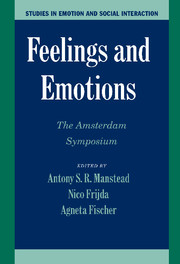Book contents
- Frontmatter
- Contents
- List of Contributors
- 1 Introduction
- PART I THE NATURE OF FEELINGS AND EMOTIONS
- 2 On the Passivity of the Passions
- 3 Emotions and Rationality
- 4 Emotions and Feelings
- 5 The Concept of an Evolved Fear Module and Cognitive Theories of Anxiety
- 6 Deconstructing the Emotions for the Sake of Comparative Research
- 7 From the Emotions of Conversation to the Passions of Fiction
- PART II BASIC PSYCHOLOGICAL PROCESSES IN FEELINGS AND EMOTIONS
- PART III FEELINGS AND EMOTIONS: THE PLACE OF PLEASURE
- PART IV FEELINGS AND EMOTIONS IN THEIR SOCIOCULTURAL CONTEXT
- PART V FEELINGS, EMOTIONS, AND MORALITY
- Subject Index
- Author Index
- Plate section
- References
4 - Emotions and Feelings
A Neurobiological Perspective
Published online by Cambridge University Press: 05 June 2012
- Frontmatter
- Contents
- List of Contributors
- 1 Introduction
- PART I THE NATURE OF FEELINGS AND EMOTIONS
- 2 On the Passivity of the Passions
- 3 Emotions and Rationality
- 4 Emotions and Feelings
- 5 The Concept of an Evolved Fear Module and Cognitive Theories of Anxiety
- 6 Deconstructing the Emotions for the Sake of Comparative Research
- 7 From the Emotions of Conversation to the Passions of Fiction
- PART II BASIC PSYCHOLOGICAL PROCESSES IN FEELINGS AND EMOTIONS
- PART III FEELINGS AND EMOTIONS: THE PLACE OF PLEASURE
- PART IV FEELINGS AND EMOTIONS IN THEIR SOCIOCULTURAL CONTEXT
- PART V FEELINGS, EMOTIONS, AND MORALITY
- Subject Index
- Author Index
- Plate section
- References
Summary
ABSTRACT
After receiving remarkable attention from scientists during the nineteenth century, emotion was relatively neglected throughout the 20th century, especially within the field of neuroscience. Recently, however, neuroscientists have begun again to advance the understanding of the neural mechanisms behind emotion.
Emotion is as much amenable to scientific study as any other aspect of behavior. Moreover, emotion is not a luxury: it is an expression of basic mechanisms of life regulation developed in evolution, and is indispensable for survival. It plays a critical role in virtually all aspects of learning, reasoning, and creativity. Somewhat surprisingly, it may play a role in the construction of consciousness.
In this chapter I review a theoretical framework which places emotion and the phenomenon that follows emotion, feeling, in an evolutionary perspective and discuss their biological roles in homeostasis. I shall also review some current evidence on neural systems involved in emotion and feeling based on the lesion method and functional neuroimaging studies.
What are emotions and feelings from the neurobiology perspective? How do organisms produce these phenomena and, in particular, how does the brain implement them? What are emotions and feelings for? Recent advances in biology, cognitive science, and neuroscience are beginning to help us answer these questions – not completely, by any means, but in ways that suggest progress is being made. In this chapter I give a sketch of some possible answers.
- Type
- Chapter
- Information
- Feelings and EmotionsThe Amsterdam Symposium, pp. 49 - 57Publisher: Cambridge University PressPrint publication year: 2004
References
- 97
- Cited by



